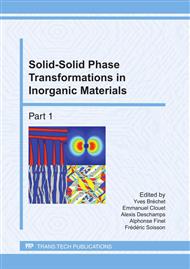[1]
J. W. Christian: The Theory of Transformation in Metals and Alloys, (Pergamon Press, Oxford, UK 2002).
Google Scholar
[2]
C. M. Wayman: Introduction to the crystallography of martensitic transformations, (MacMillan, New York 1964).
Google Scholar
[3]
M. -X. Zhang, and P. M. Kelly: Prog. Mater. Sci. Vol. 54 (2009), p.1101.
Google Scholar
[4]
W. -Z. Zhang, and G. C. Weatherly: Progress in Materials Science Vol. 50 (2005), p.181.
Google Scholar
[5]
A. P. Sutton, and R. W. Balluffi: Interfaces in crystalline materials, (Oxford University Press, Oxford 1995).
Google Scholar
[6]
J. M. Howe: Interfaces in materials, (John Wiley and Sons, New York 1997).
Google Scholar
[7]
D. A. Porter, and K. E. Easterling: Phase transformations in metals and alloys, (Chapman and Hall, New York 1992).
Google Scholar
[8]
L. Vitos, A. V. Ruban, H. L. Skriver, and J. Kollar: Surface Science Vol. 441 (1998), p.186.
Google Scholar
[9]
J. G. Che, and C. T. Chan: Physical Review B Vol. 57 (1998), p.1875.
Google Scholar
[10]
S. C. Erwin, L. Zu, M. I. Haftel, A. L. Efros, T. A. Kennedy, and D. J. Norris: Nature letter Vol. 436 (2005), p.91.
DOI: 10.1038/nature03832
Google Scholar
[11]
W. A. Tiller: The Science of Crystallization: Microscopic Interfacial Phenomena, (Cambridge University Press, New York 1991).
Google Scholar
[12]
T. Furuhara, J. M. Howe, and H. I. Aaronson: Acta Metallurgica et Materialia Vol. 39 (1991), p.2873.
DOI: 10.1016/0956-7151(91)90104-9
Google Scholar
[13]
T. Furuhara, T. Ogawa, and T. Maki: Philosophical Magazine Letters Vol. 72 (1995), p.175.
Google Scholar
[14]
W. Bollmann, and H. -U. Nissen: Acta Cryst. Vol. 24A (1968), p.546.
Google Scholar
[15]
W. Bollmann: Crystal lattices, interfaces, matrices, (Bollmann, Geneva 1982).
Google Scholar
[16]
A. P. Sutton, and V. Vitek: Philos. Trans. R. Soc. Lond. Vol. 309 A (1983), p.1.
Google Scholar
[17]
W. Bollmann: Crystal defects and crystalline interfaces, (Springer, Berlin 1970).
Google Scholar
[18]
W. -Z. Zhang, and G. R. Purdy: Phil. Mag. Vol. 68A (1993), p.279.
Google Scholar
[19]
W. -Z. Zhang, and G. R. Purdy: Phil. Mag. Vol. 68A (1993), p.291.
Google Scholar
[20]
F. Ye, W. -Z. Zhang, and D. Qiu: Acta Materialia Vol. 54 (2006), p.5377.
Google Scholar
[21]
D. Qiu, and W. -Z. Zhang: Acta Materialia Vol. 55 (2007), p.6754.
Google Scholar
[22]
F. Ye, and W. -Z. Zhang: Acta Materialia Vol. 54 (2006), p.871.
Google Scholar
[23]
D. Qiu, and W. -Z. Zhang: Acta Materialia Vol. 56 (2008), p. (2003).
Google Scholar
[24]
X. -F. Gu, and W. -Z. Zhang: Phil. Mag. Vol. 90 (2010), p.4503.
Google Scholar
[25]
F. Ye, and W. Z. Zhang: Acta Materialia Vol. 50 (2002), p.2761.
Google Scholar
[26]
M. Zhang, W. -Z. Zhang, and F. Ye: Metall. Mater. Trans. Vol. 36A (2005), p.1681.
Google Scholar
[27]
W. -Z. Zhang, F. Ye, C. Zhang, Y. Qi, and H. S. Fang: Acta Materialia Vol. 48 (2000), p.2209.
Google Scholar
[28]
W. -Z. Zhang: Scripta Materialia Vol. 37 (1997), p.187.
Google Scholar
[29]
H. Grimmer: Scripta Metallurgica Vol. 8 (1974), p.1221.
Google Scholar
[30]
Q. Liang, and W. T. Reynolds, Jr.: Metallurgical and Materials Transactions A (Physical Metallurgy and Materials Science) Vol. 29A (1998), p. (2059).
Google Scholar
[31]
X. -P. Yang, and W. -Z. Zhang: Poster in iib2007 (2007).
Google Scholar
[32]
M. Zhang, W. -Z. Zhang, G. -Z. Zhu, and Y. Kun: Trans. Nonferrous Met. Soc. China Vol. 17 (2007), p.1428.
Google Scholar
[33]
W. -Z. Zhang, and J. Wu: Mater. Sci. and Eng. Vol. A438-440 (2006), p.118.
Google Scholar
[34]
J. W. Cahn: Acta Metallurgica Vol. 8 (1960), p.554.
Google Scholar
[35]
J. W. Cahn, and G. Kalonji. Symmetry in solid state transformation morphology., Solid to Solid Phase Transformations. Eds. Aaronson, H. I., D. E. Laughlin, R. F. Sekerka and C. M. Wayman. Warrendale, USA: TMS, 1981. 3.
Google Scholar
[36]
M. G. Hall, H. I. Aaronson, and K. R. Kinsma: Surface Science Vol. 31 (1972), p.257.
Google Scholar
[37]
P. M. Kelly, and M. X. Zhang: Material Forum Vol. 23 (1999), p.41.
Google Scholar


